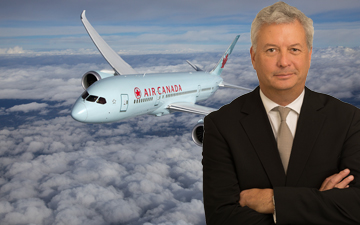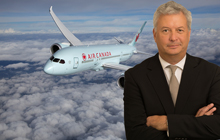Part One: Pensions, planes & profits (pension deficits)

In the first of a three part-series, CFO of the Year Michael Rousseau, CPA, CA, shares the management strategies that has Air Canada soaring once again
OTTAWA, June 1, 2017 – Michael Rousseau, CPA, CA, executive vice president and chief financial officer of Air Canada Corporation in Montreal, has presided over a remarkable financial turnaround at Air Canada since 2007. For that he was recognized as the CFO of the Year by FEI Canada in March 2017. In the first of a three-part series, Rousseau details the financial strategy undertaken to repair the national airline’s sizable pension plan deficit.
When the veteran CFO came on board, the airline was rebounding from a $74 million net loss in 2006. Last year, Air Canada reported net income of $876 million, with record adjusted net income of $1.147 billion, taking into account earnings before interest, taxes, depreciation, amortization, impairment and aircraft rent. The company’s stock price is now around $13 per share, after hitting a low of $0.97 in 2009 during the depths of the financial crisis.
“It’s been such an incredible ride,” says Rousseau. “The first four or five years were really spent repairing the financial issues, improving relationships with all stakeholders and developing a path forward,” he explains. “The last four or five years have been taking advantage of those opportunities we have created, and the market has rewarded us for all our hard and excellent work.”
The change in financial fortunes was rooted in having to adapt to tough economic times.
“When I joined Air Canada our balance sheet was not very strong. As a result, it couldn’t deal with an economic shock like the 2008-09 financial crisis,” says Rousseau, who adds that the actions taken then, such as reducing the company’s cost structure, were critical to stabilizing the company and creating a stronger balance sheet.
“We had to manage cash very tightly. That led to difficult trade-off decisions regarding investments. More importantly, we had to start building liquidity not only to replenish what we had used during the crisis but also to fund future growth,” he recalls.
Pension Reform
Air Canada has a very large pension plan covering approximately 30,000 retirees and 26,000 active employees and has committed to paying each of them their full earned pension plan benefits, Rousseau stresses.
“Much of the very intensive work around pension reform, raising liquidity, reducing costs and extending labour contracts was completed in 2009 and 2010. We spent a lot of time with the leadership groups of the unions getting their support and working with the federal government developing some special arrangements for pension funding. At the same time I was working with the international management consulting Mercer Group on creating a new investment strategy for our pension plan,” explains Rousseau.
There was a $6.1 billion turnaround in a five year period, from a $4.2 billion deficit, representing almost 40 per cent of liabilities in early 2012, to a $1.9 billion surplus as at January 1, 2017, says Rousseau.
“We contributed $1 billion over the five years and negotiated with our union groups for a change in early retirement benefits that reduced the liabilities by $1 billion. The other $4 billion is from investment returns, which is the result of us changing and executing our investment strategy,” he elaborates.
Part of Air Canada’s strategy to strengthen its pension plan involved significantly lowering its risk profile by having a large portion of its portfolio consist of fixed income investments in a low interest rate environment.
“We wanted to immunize a major portion of the liabilities. The major risk to pension plans is the discount rate or the interest rate risk. Low interest rates really hurt pension plans because you have to discount your liabilities at that low interest rate. So when you can match more bonds, which are interest rate sensitive, with the liabilities, which are also interest rate sensitive, they cover each other,” Rousseau explains.
“Today we’ve matched 75 per cent of our liabilities with a corresponding fixed income or interest rate sensitive investment,” he adds.
Jeff Buckstein, CPA, CGA, is an Ottawa-based business journalist. Michael Rousseau image courtesy Michael Rousseau. Air Canada Boeing 787-9 Dreamliner courtesy Air Canada media photos.










(0) Comments